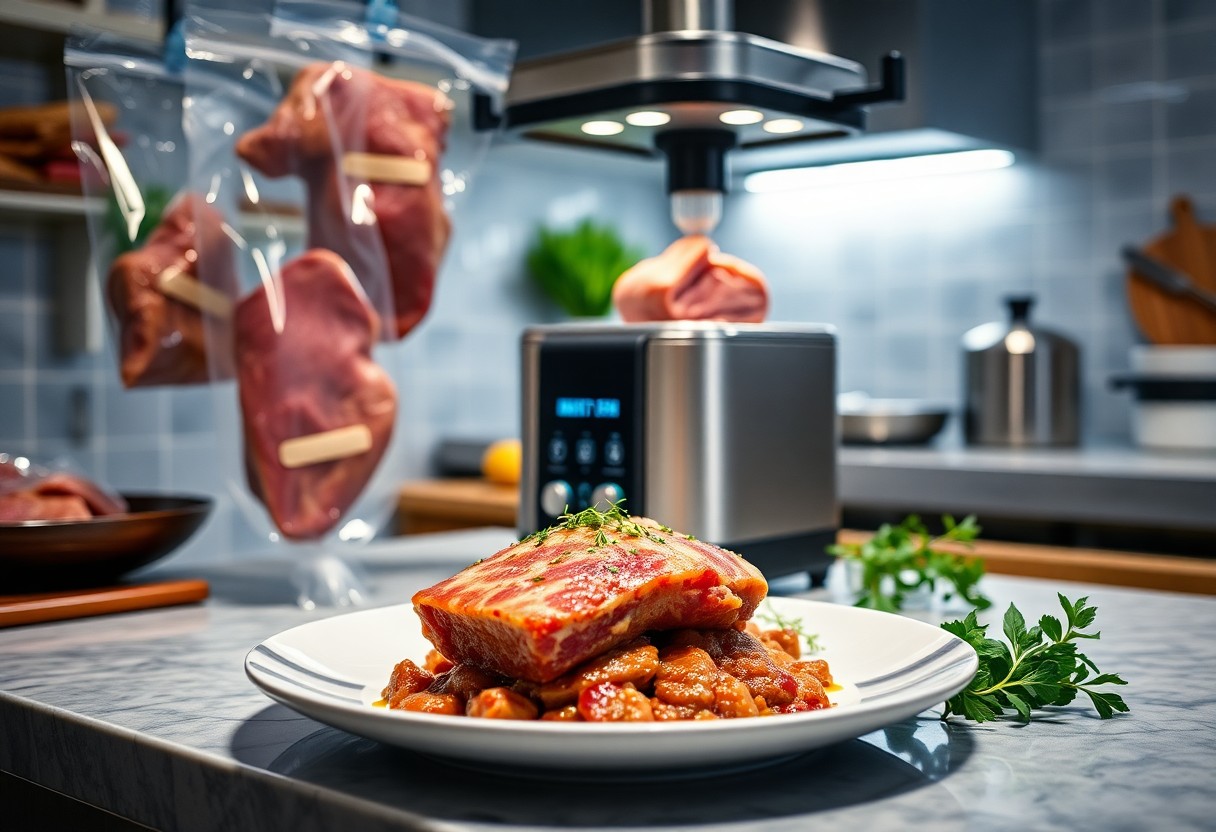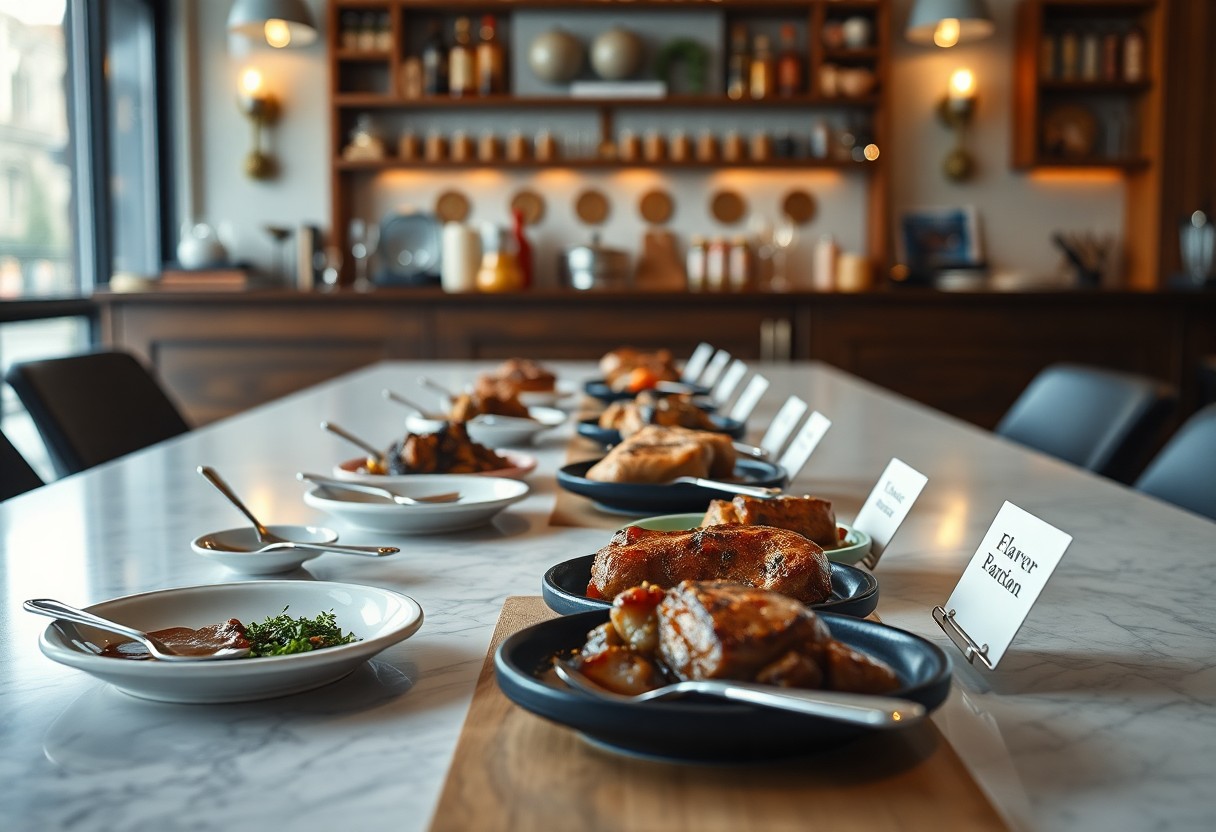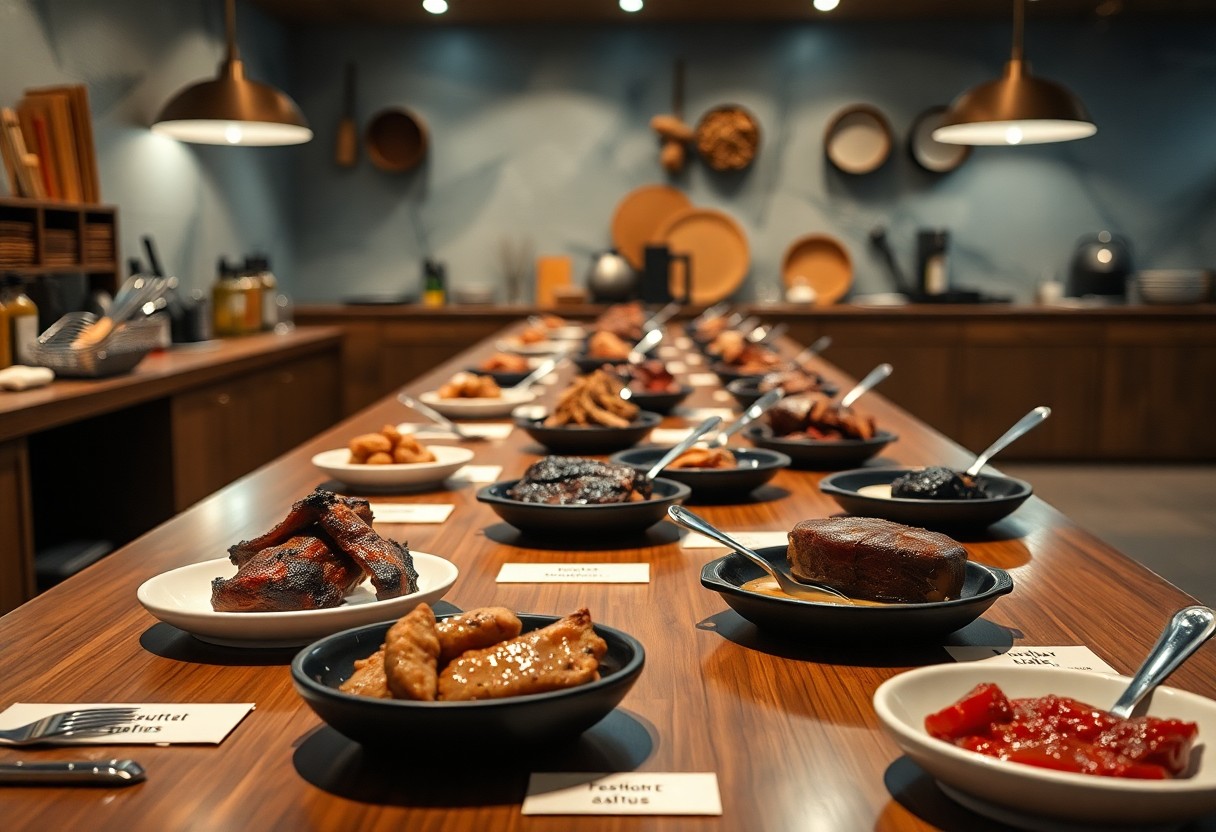It’s changing the game in culinary techniques: reverse cooking. This innovative method alters the way you prepare meat, allowing you to enjoy more juicy and tender results while also reducing the risk of overcooking. By cooking meat at a lower temperature first, you can enhance its flavor profile and ensure even doneness throughout. As you explore this transformative approach, you’ll not only impress your guests but also elevate your kitchen skills to new heights.

Key Takeaways:
- Reverse cooking involves starting with meat at a low temperature, allowing for even cooking and retention of moisture, which enhances flavor and texture.
- This technique often reduces cooking time and energy consumption, making meat preparation more efficient and eco-friendly.
- Utilizing reverse cooking can inspire creativity in meal planning, encouraging chefs to explore unique seasoning and pairing options that complement the slow-cooked meat.
The Culinary Revolution of Reverse Cooking
Defining Reverse Cooking and Its Origins
Reverse cooking refers to the technique of cooking meat starting at a low temperature, often through sous-vide methods, before applying high heat to achieve a seared crust at the end. Originating from professional kitchen practices aimed at achieving precise control over cooking temperatures, this method has now permeated home kitchens. Its growing popularity can be attributed to how it maintains juiciness and enhances overall flavor, signaling a significant shift in culinary practices.
How Reverse Cooking Contrasts Traditional Methods
This method starkly contrasts traditional cooking techniques that typically start with high heat, cooking the exterior first while risking overcooking the interior. While traditional methods favor direct flame cooking, which often results in uneven textures and lost moisture, reverse cooking allows for a controlled environment. By gradually raising the temperature, proteins break down more effectively, resulting in tender cuts that retain their natural juices. Moreover, the final searing step adds flavor while preserving the internal doneness achieved earlier.
The Science That Makes It Work
The technique of reverse cooking not only enhances flavors but also guarantees an ideal texture through precise temperature control. By maintaining a consistent low temperature, you allow proteins to break down gradually, leading to incredible tenderness. This method also reduces the risk of overcooking, which is a common issue with traditional cooking methods. Focusing on the science behind this technique reveals how the careful management of heat influences the final dish, turning a simple cut of meat into a succulent masterpiece.
Understanding Temperature Control and Flavor Development
| Temperature Range | Optimal cooking temperatures vary based on the type of meat, ensuring perfect doneness. |
| Flavor Enhancement | Slow cooking amplifies the natural flavors and creates a deeper, more complex taste. |
| Moisture Retention | Lower temperatures help retain juices, producing a more succulent result. |
| Protein Breakdown | Gradual heating allows collagen to dissolve, enhancing tenderness. |
The Role of Sous Vide in Reverse Cooking
Sous vide stands at the forefront of reverse cooking as a powerful method that provides unparalleled precision. This technique involves sealing food in vacuum-sealed bags and immersing them in a water bath at a meticulously controlled temperature. By using sous vide, you ensure that every bit of meat is cooked evenly throughout, eliminating the dreaded ‘overdone’ exterior and ‘undercooked’ interior. The result is consistently tender, flavorful meat that elevates your cooking game.
Utilizing sous vide for reverse cooking amplifies the technique’s benefits, allowing you to explore various flavor profiles while achieving perfect doneness. Imagine cooking a steak to a precise 130°F for a perfect medium-rare, all while retaining its natural juices. With the time flexibility that sous vide provides, you can infuse your meat with marinades or herbs before cooking, enhancing flavor without compromising texture. This method thus not only transforms how you prepare your meat but also opens doors to culinary creativity in your kitchen, delivering restaurant-quality results every time.
Transformational Techniques for Meat Preparation
Reverse cooking reshapes your approach to meat preparation, allowing you to achieve perfectly tender and juicy results. By utilizing low-temperature cooking methods, this technique ensures consistent doneness throughout the cut while significantly enhancing flavor and texture. Experimenting with sous-vide or slow-roasting techniques can elevate your dishes to restaurant-quality creations, ensuring that every bite is satisfying and succulent.
Step-by-Step Guide to Reverse Cooking Meats
Follow these easy steps for your reverse cooking journey:
| Step | Description |
| 1 | Choose your meat cut and season it well. |
| 2 | Cook the meat at a low temperature, ideally around 135°F to 150°F. |
| 3 | Once the meat reaches the desired temperature, remove it from the heat. |
| 4 | Sear the meat quickly on a hot grill or skillet for a caramelized crust. |
| 5 | Rest the meat briefly before slicing to retain juices. |
Common Mistakes and How to Avoid Them
Many find themselves tripped up by small oversights when reverse cooking. Skipping the resting period post-cooking can lead to juices spilling out upon slicing, resulting in dry meat. Moreover, cooking at too high a temperature initially can compromise tenderness—both of which can be easily managed with care and attention to detail.
To ensure optimal results, invest in a reliable meat thermometer that can help check internal temperatures accurately. Avoid starting with frozen meat as it can lead to uneven cooking, sacrificing that desired tenderness. Always allow your meat to rest for at least five minutes after searing so the juices redistribute evenly throughout. By reinforcing these practices, your confidence and skills in reverse cooking will continually grow, leading to meat preparation success with each attempt.

Taste Test: Flavor Profiles and Consumer Response
In terms of taste, reverse cooked meat is notable for its enhanced flavor profiles. Many consumers report a deeper, richer taste compared to conventional methods. The gradual cooking process ensures that seasonings and marinades penetrate more effectively, creating a unified and satisfying flavor experience. As more diners sample reverse cooked dishes, their enthusiasm echoes across culinary circles, impacting overall preferences and driving demand for this innovative technique.
Comparing Reverse Cooked Meat to Conventional Methods
| Reverse Cooked Meat | Consistently tender, flavorful, and evenly seasoned; minimizes dry spots. |
| Conventional Methods | More variable in doneness; often leads to overcooked exterior and undercooked interior. |
Panel Insights: What Top Chefs Think
Chefs have warmly embraced reverse cooking, citing its capacity to revolutionize meat preparation. Many agree that this method leads to superior flavor and texture, allowing for a more artistic approach to plating and presentation. By retaining moisture and enhancing seasonings, chefs believe they can create unforgettable dining experiences that balance innovation and tradition.
As culinary professionals embrace reverse cooking, insights abound. Renowned chefs note that the method encourages creativity in their dishes, allowing for experimentation with flavors and ingredients previously considered challenging. For instance, Chef Lisa Smith from New York emphasizes how reverse cooking has allowed her to explore bold marinating techniques without the risk of losing tenderness or flavor integrity. This newfound freedom not only enhances personal expression in the kitchen but also brings customers back for more innovative fare, truly setting a new standard in meat preparation.
The Future of Meat Preparation: Trends and Innovations
Emerging trends in meat preparation reveal an increasing shift toward processes that enhance both flavor and nutrition. As consumers become more health-conscious and environmentally aware, innovations in techniques like reverse cooking will likely gain traction. Expect to see developments such as the integration of advanced kitchen technology, personalized cooking methods based on dietary needs, and even the introduction of AI-driven tools that optimize meat preparation for flavor and tenderness.
Eco-Friendly Practices and Their Alignment with Reverse Cooking
Reverse cooking aligns seamlessly with eco-friendly practices, utilizing low-energy methods that reduce waste. By preserving natural juices and nutrients, this technique minimizes the need for additives and excessive seasoning. Additionally, the ability to cook meat to perfection at lower temperatures significantly cuts down energy consumption, making it a sustainable choice in the kitchen.
Possible Industry Shifts and Consumer Impacts
As reverse cooking becomes more popular, the meat industry may experience a transformative shift. With consumers actively seeking methods that enhance flavor without compromising health, you could see a rise in demand for meats prepared using this technique. This shift might encourage farms to adopt sustainable farming practices and push manufacturers to focus on quality over quantity, ensuring that flavor innovations do not come at the cost of ethical sourcing and animal welfare.
A potential shift in industry standards could lead to greater transparency regarding sourcing and preparation methods, offering consumers more control over their dietary choices. As reverse cooking takes center stage, brands that champion these sustainable practices may gain a competitive edge. Moreover, you can expect a continuous evolution in consumer preferences, with many gravitating towards grass-fed, organic, and ethically raised options to complement their newfound cooking techniques. In this way, consumer demand may motivate producers to invest in more responsible practices, driving a holistic change in the meat preparation landscape.
To wrap up
With these considerations, you can appreciate how ‘reverse cooking’ is revolutionizing your approach to meat preparation. This innovative technique not only ensures precise cooking temperatures but also enhances flavor and tenderness, allowing you to achieve restaurant-quality results at home. By mastering this method, you can elevate your culinary skills, impress your guests, and enjoy meals that are consistently delicious. Embracing reverse cooking guarantees that every cut of meat takes center stage on your dining table, transforming your cooking experience into something extraordinary.
FAQ
Q: What is reverse cooking, and how does it differ from traditional methods?
A: Reverse cooking, often referred to as sous-vide cooking, is a method where food is cooked in a temperature-controlled water bath for an extended period. Unlike traditional methods where food may be cooked at high temperatures that can lead to uneven cooking and moisture loss, reverse cooking ensures that the meat is cooked evenly throughout. It allows for precise temperature control, preserving the natural flavors and juices of the meat.
Q: What advantages does reverse cooking provide for meat preparation?
A: One of the primary advantages of reverse cooking is the ability to achieve perfect doneness. The low and slow cooking method ensures that the meat reaches the desired internal temperature without overcooking. Additionally, this method enhances the tenderness and juiciness of the meat, as it retains more moisture compared to conventional cooking. The flavors can also be intensified, resulting in a more flavorful dining experience.
Q: Can all types of meat be prepared using reverse cooking?
A: Yes, reverse cooking can be utilized for various types of meat, including beef, pork, chicken, and lamb. Each type of meat may have different ideal cooking times and temperatures. For example, a steak may need to be cooked at a lower temperature for a shorter period compared to a tougher cut like brisket, which benefits from longer cooking times. It’s vital to research and adjust the timing and temperature accordingly for the best results.
Q: How does reverse cooking impact the safety of meat preparation?
A: Reverse cooking, when done correctly, is safe and can actually enhance food safety. By maintaining a constant temperature and cooking for an extended time, harmful bacteria can be effectively eliminated. However, it is important to follow food safety guidelines, such as ensuring the meat is cooked to the appropriate internal temperature and avoiding cross-contamination during preparation.
Q: What equipment is needed for reverse cooking, and is it accessible for home cooks?
A: The primary equipment needed for reverse cooking is a sous-vide immersion circulator or a precision cooker, along with vacuum-sealed bags to hold the meat. These devices have become more accessible and affordable for home cooks in recent years. Many modern kitchen appliances also incorporate sous-vide functions. While the initial investment in equipment can be higher, the ability to achieve restaurant-quality results at home often justifies the expense.
